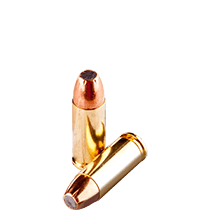
9x23mm Winchester Ammo For Sale
History of 9x23mm Winchester Ammo
The development and manufacturing history of 9x23 Winchester ammo is somewhat complicated due to its original intention, modifications, and legal issues. It was developed through a collaboration between Winchester Ammunition and Colt Manufacturing Company in the 1990s, and was introduced to competition shooters as a replacement for the .38 Super. Shooters affiliated with the The United States Practical Shooting Association (USPSA), the International Defensive Pistol Association (IDPA), and the International Practical Shooting Confederation (IPSC) had been experiencing catastrophic failures because they were trying to reach major power factor by combining firearms and calibers that were ill suited to such high pressures. To solve the ongoing problems, the 9x23mm Winchester was designed to permit safer and faster shooting by sport shooters, while still providing major power factor.
Major Power Factor and the 9x23mm
To be considered a major power factor for competition in these disciplines, the ammo must meet certain criteria. If the requirements are met, the shooter will not incur scoring penalties for minor power factor ammunition.
Power factor is calculated by multiplying the bullet weight times the velocity and dividing the result by 1,000. In 1996, the minimum score to be considered major power factor was 175. A .38 Super would need a bullet weighing 130 grains and would need to travel at 1,350 feet per second to qualify as major. This was possible for a .38 Super, but it was also close to safety limits.
In the end, there were enough problems to motivate Winchester Ammunition to collaborate with Colt Manufacturing Company for a solution. They developed a cartridge that combined the increased magazine capacity of bullets with a diameter of 9mm. The result was the 9x23mm Win, capable of handling the higher pressures generated by pushing a bullet that size to major power factor velocities.
The 9x23mm Winchester bullet diameter was the same as the .38 Super, so competitors already had many of the necessary components for loading their own ammo. The similarities, however, between the .38 Super and the 9x23mm end here. John Ricco designed the strengthened case in 1992, which allowed about 25 percent higher case pressures for the 9x23 – calling it the 9x23 Super.
A critical feature of the 9x23mm Winchester, aside from the strengthened case, is that it eliminated the semi-rimmed case of the .38 Super, the culprit behind that round’s continued feeding problems. The strengthened case also permitted the round to function using a higher internal pressure, 55,000 psi compared to the maximum pressure of the .38 Super, which is 36,500 psi (current SAAMI standards).
The IPSC reduced the major power factor during this time from 175 to 165, which made the .38 Super a safe choice for shooters. This struck a blow to the popularity of the 9x23, since there were many users of the .38 Super. As a result, the 9x23mm became a novelty cartridge.
Unfortunately, perhaps due to its origins, it has never been accepted as a cartridge for personal protection – even though the ballistics of the 9x23mm are better than the .357 SIG, including a higher magazine capacity.
9x23mm Winchester Ballistics: Chart of Average 9x23mm Winchester Ballistics
Note: This information comes from the manufacturer and is for informational purposes only. The actual ballistics obtained with your firearm can vary considerably from the advertised ballistics. Also, ballistics can vary from lot to lot with the same brand and type load.
| 9x23mm Winchester Bullet WEIGHT | Muzzle VELOCITY (fps) | Muzzle ENERGY (ft. lbs.) | Mid-Range TRAJECTORY (in.) | Barrel Length (in.) | |||||
|---|---|---|---|---|---|---|---|---|---|
| Muzzle | 50 yds. | 100 yds. | Muzzle | 50 yds. | 100 yds. | 50 yds. | 100 yds. | ||
| 124 Grain | 1190 | 1055 | 966 | 390 | 306 | 257 | 0.7 | 3.7 | 4" |
| 125 Grain | 1450 | 1249 | 1103 | 583 | 433 | 338 | 0.6 | 2.8 | n/a |
